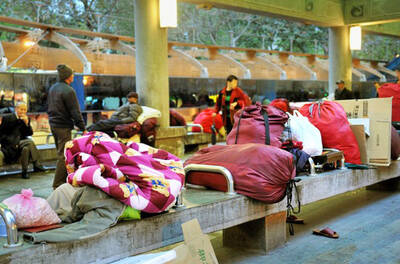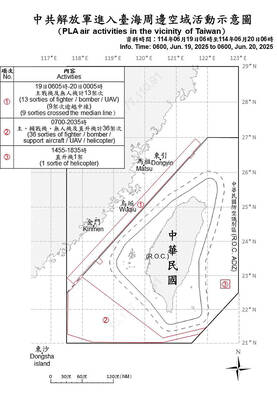Consumers of selected Taiwanese teas will now be able to trace the path their tea took from the farm to their cup through the Taiwan Agriculture and Food Traceability System (TAFT).
"By typing the identifying barcode into the TAFT Web site, consumers will be able to access information such as where their tea was grown, when it was harvested and what pesticides and herbicides, if any, were used to produce it," said Kuo Chung-chin (郭聰欽), the executive officer of the Integrated Agricultural Development Foundation. "We are going to address consumer concerns by making production processes completely transparent."
In addition to the production information, consumers will also be able to see pictures of the farms where the tea was grown and the farmers who grew it. Other products already on the market under the TAFT system include Taiwanese fruits and rice. All products in the scheme are identified by a distinctive scannable sticker.
According to Kuo, Taiwanese agricultural produce has been plagued by pesticide and herbicide residue issues both at home and abroad.
"Consumer confidence can be shattered by just a few reports of possibly harmful produce," Kuo said. "By doing a better job of documenting our agricultural practices, we will be able to isolate the source of tainted produce and protect the producers who are playing by the rules."
Production records are also important when it comes to exporting Taiwanese produce abroad.
"The already-strict standards for agricultural imports in Japan are set to be raised even higher in 2008. A good `production resume' will become necessary to export there," said Chen Hsuan (
According to Chen, Taiwan exports around 4,000 tonnes of tea from a total production of 20,000 tonnes annually. Taiwan mostly exports high-quality Oolong teas to Japan, with niche markets in Europe and the US. However, the Taiwanese are such voracious tea drinkers that Taiwan is almost a net importer of tea.
"We import a little less than 20,000 tonnes of lower-quality tea from countries such as Vietnam," Chen said. "Those cheaper leaves are used in bottled teas, flavored teas and other low-end applications."
There were widespread fears that cheap teas from China would threatened Taiwanese producers, Chen said, but a burgeoning Chinese domestic market fueled by the rapidly expanding economy there has absorbed almost all the supply.
"We export teas to China," said Chen, adding that good quality Taiwanese Ti Kuan Yin tea can fetch 1,000 yuan (US$127) for 500g.
"If you divide the quantity of tea leaves grown for the domestic market and imported by the population, the average Taiwanese consumes 1.6kg of tea annually," Chen said.

A year-long renovation of Taipei’s Bangka Park (艋舺公園) began yesterday, as city workers fenced off the site and cleared out belongings left by homeless residents who had been living there. Despite protests from displaced residents, a city official defended the government’s relocation efforts, saying transitional housing has been offered. The renovation of the park in Taipei’s Wanhua District (萬華), near Longshan Temple (龍山寺), began at 9am yesterday, as about 20 homeless people packed their belongings and left after being asked to move by city personnel. Among them was a 90-year-old woman surnamed Wang (王), who last week said that she had no plans

TO BE APPEALED: The environment ministry said coal reduction goals had to be reached within two months, which was against the principle of legitimate expectation The Taipei High Administrative Court on Thursday ruled in favor of the Taichung Environmental Protection Bureau in its administrative litigation against the Ministry of Environment for the rescission of a NT$18 million fine (US$609,570) imposed by the bureau on the Taichung Power Plant in 2019 for alleged excess coal power generation. The bureau in November 2019 revised what it said was a “slip of the pen” in the text of the operating permit granted to the plant — which is run by Taiwan Power Co (Taipower) — in October 2017. The permit originally read: “reduce coal use by 40 percent from Jan.

China might accelerate its strategic actions toward Taiwan, the South China Sea and across the first island chain, after the US officially entered a military conflict with Iran, as Beijing would perceive Washington as incapable of fighting a two-front war, a military expert said yesterday. The US’ ongoing conflict with Iran is not merely an act of retaliation or a “delaying tactic,” but a strategic military campaign aimed at dismantling Tehran’s nuclear capabilities and reshaping the regional order in the Middle East, said National Defense University distinguished adjunct lecturer Holmes Liao (廖宏祥), former McDonnell Douglas Aerospace representative in Taiwan. If

‘SPEY’ REACTION: Beijing said its Eastern Theater Command ‘organized troops to monitor and guard the entire process’ of a Taiwan Strait transit China sent 74 warplanes toward Taiwan between late Thursday and early yesterday, 61 of which crossed the median line in the Taiwan Strait. It was not clear why so many planes were scrambled, said the Ministry of National Defense, which tabulated the flights. The aircraft were sent in two separate tranches, the ministry said. The Ministry of Foreign Affairs on Thursday “confirmed and welcomed” a transit by the British Royal Navy’s HMS Spey, a River-class offshore patrol vessel, through the Taiwan Strait a day earlier. The ship’s transit “once again [reaffirmed the Strait’s] status as international waters,” the foreign ministry said. “Such transits by